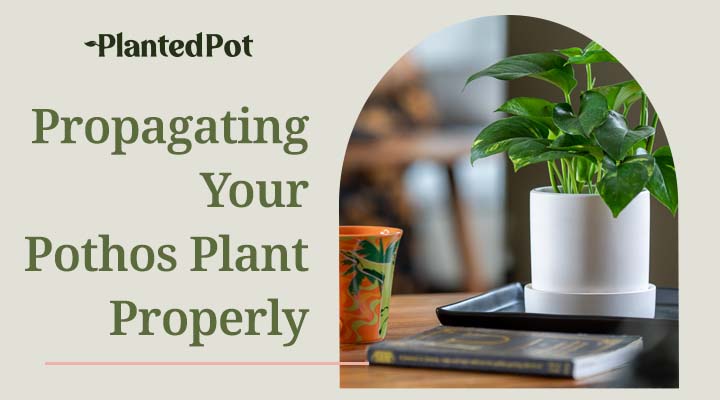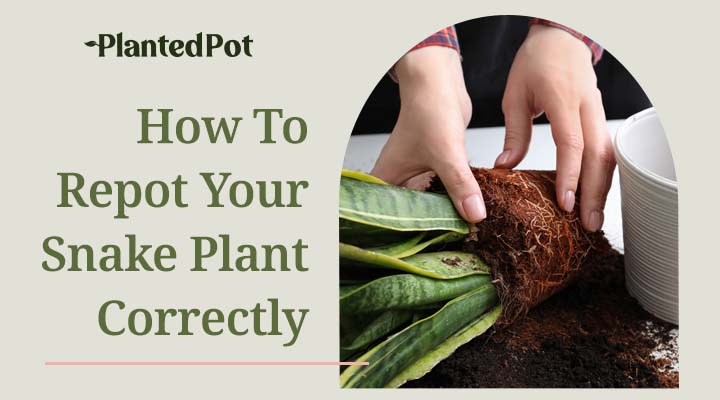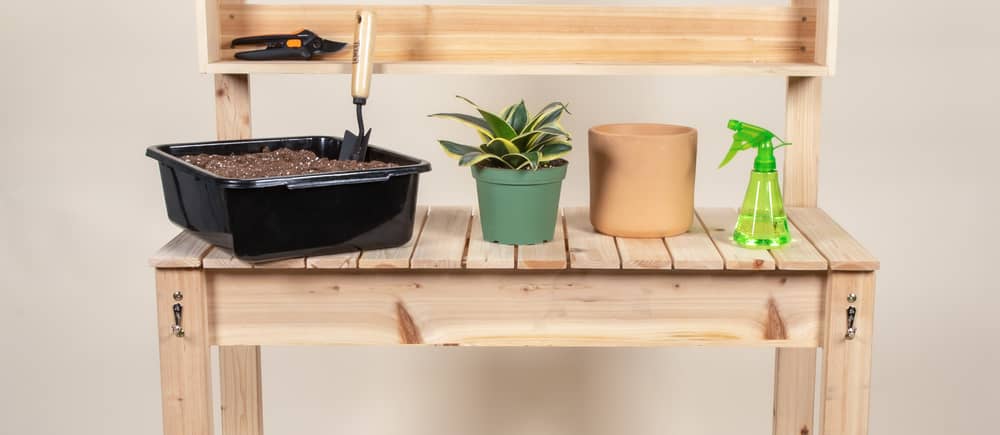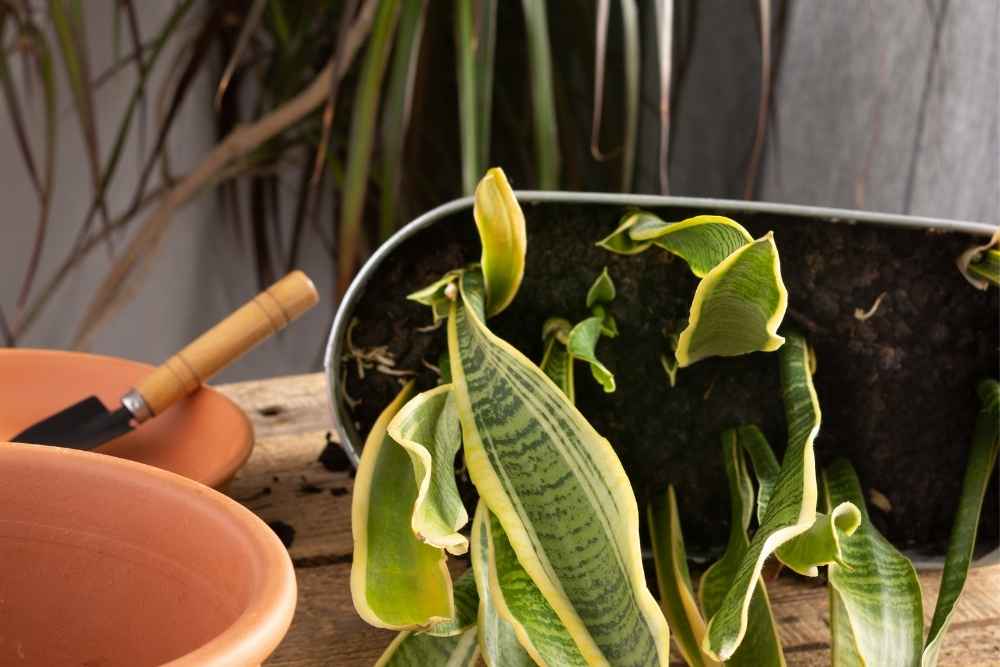
Repotting Snake Plant [Tips & Tricks To Keep Your Plant Healthy!]
Home / Repotting Snake Plant [Tips & Tricks To Keep Your Plant Healthy!]

Repotting Snake Plant [Tips & Tricks To Keep Your Plant Healthy!]
- Ash Chauhan
- October 20, 2021
- 12:03 pm
- No Comments
Do you notice a slight bulge in the pot of that beautiful Snake Plant you have on display? How about thin, stringy roots seeping out from the drainage holes on the bottom of the pot? Does the soil look crumbled and in need of a little more perlite? If so, then it just might be time for you to think about repotting your Snake Plant. However, it’s not as simple as you might think.
Snake Plants are versatile indoor plants found just about everywhere. When coupled with their whimsical beauty, their popularity has made Snake Plants into a decorative showstopper for many homes. If you notice your Snake Plant outgrowing their existing pot, then it might be time for a much-needed repotting. Let’s take a look!
What Are Snake Plants?
The reputation of Snake Plants precedes their slithery surname. These hardy plants are found in several varieties, including Bowstring Hemp, Starfish Snake Plant, and African Spear Plant – named after their native habitat. The most popular variety of Snake Plants is the Mother-In-Law’s Tongue and is a decorative staple of many homes.

Appearance
Snake Plants are prized for their showy, tall leaves that rise from the soil. These leaves are thick, sword-like protrusions punctuated by yellow and green reptilian patterns. The leaves are clumped at the base but spread out laterally the taller they get.
Although beautiful, Snake Plant leaves can be toxic if consumed, causing burning and swelling of the tongue. Be sure to watch young children and pets carefully if you plan on having this plant in your home!
Optimal Growing Conditions
Similar to a succulent plant, Snake Plants are typically very slow-growing. You can plant them outdoors, but they should never receive direct sunlight. Most Snake Plants prefer indirect light like those found indoors and don’t mind being pot-bound.
These tropical houseplants can go up to a month without watering! A general rule of thumb is to check if the top 1-2 inches of soil is dry. If so, then it’s time to give your Snake Plant a drink. Make sure to keep the plant in a well-draining pot so you can avoid excess moisture causing root rot.
Benefits
A 1989 NASA study concluded that certain indoor plants, like the Snake Plant, can help purify indoor air. This is one of the reasons why Snake Plants have become a popular house plant with homeowners. Depending on the number of Snake Plants homeowners have and the size of the room they are displayed in, Snake Plants can help remove toxins in the air like nitrogen oxides, formaldehyde, benzene, and xylene, just to name a few.
What Does It Mean to Repot a Snake Plant?
Just like children who outgrow their clothes, Snake Plants eventually outgrow their pots. Fortunately, these plants are slow-growing. Most people typically repot a Snake Plant every two years, though some plants can go 4-6 years without being repotted.
What Are the Benefits of Repotting Snake Plants?
More than just a flashy new pot to showcase your prized plant, repotting allows your Snake Plant to grow properly. There are many benefits to repotting a Snake Plant:
- Aesthetics: Plants grow into beautiful specimens. To properly accentuate their attractiveness, they must also have an equally beautiful pot. Repotting allows you to change up the aesthetics of your current pot and help add an artistic touch.
- Room For Growth: By repotting a plant, you give it ample room to grow in a big new pot. This helps to prevent stunted growth and prevents the plant from being root-bound.
- Dividing the Plant: Although Snake Plants grow slowly, the solution can’t always be to keep putting them into bigger pots every other year. Dividing a whole Snake Plant into smaller segments and repotting each into a separate pot will help your plants flourish.
- Boosting Nutrition: Snake Plants sitting in the same soil for a long time will often be depleted of nutrients. Repotting will give your plant fresh soil that will aid its nutrition and allow for healthy growth.
- Disease Prevention: Plants sitting in the same soil can become depleted of nutrients, become root bound, and suffer from compact soil. Frequent watering can make the situation worse and lead to rot and disease. By repotting a plant, you can help replenish it and prevent it from suffering from a perfect storm of disease-causing conditions.
When Should You Repot A Snake Plant?
If you notice your Snake Plant’s pot start to bulge, then that might be a good time to replant it. Swelling is the most obvious sign that you need to repot your Snake Plant. You can easily see bulging in plastic pots. However, if your Snake Plant’s pot is made of a thicker, durable material like a clay pot, this sign can be harder to spot.
Fortunately, there are other symptoms to look for when determining whether or not you should repot a Snake Plant are:
- Dangling roots that extend through the drainage holes.
- Thick, large roots accumulated in the root ball, poking through the top of the soil.
- Water flowing through the drainage holes during or immediately following a watering.
- Shrinking potting soil inside of the pot.
- Drooping leaves or leaves that wilt quickly after a thorough watering.
- A top-heavy plant that’s constantly falling or tipping over.
- Expected growth has slowed.
Why Do Snake Plants Need to Be Repotted?
Snake plants spread out laterally as they grow. They can outgrow their old pot and become prone to problems like becoming root-bound or developing root rot. You should continue repotting Snake Plants to ensure that they continue to thrive.
How Deep Should I Repot My Snake Plant?
Use your Snake Plant’s old pot as a guide to determine how deep your new pot should be. Just add 1 to 2 inches to your current pot’s size to determine your new pot size.
Snake Plants don’t need a deep pot. When planting or repotting Snake Plants, use new pots that have ample space for the plant to branch out while being shallow and sturdy enough to not cause the plant to tip over. A deeper, larger pot leads to soil mix accumulating at the bottom. This can trap excess water and can lead to rot and potentially the death of your Snake Plant.

How to Repot a Snake Plant
Now that you know about what makes a Snake Plant unique and when you should repot it, it’s time you learned how to! Just follow these simple steps on repotting your beautiful Snake Plant!
- Gather: Grab your new pot, a bag of potting mix, a small hand shovel, and your Snake Plant and go outside to prepare for your repotting. If repotting indoors, use a tarp to protect your floor.
- Loosen: For plastic pots, gently but firmly press the grow pot from the sides to loosen the plant. If you have a thicker pot, use a dull knife to loosen the root ball from the sides of the pot.
- Lift: Gently lift the plant with one hand and support the entire root ball with your other hand.
- Situate: Place the Snake Plant into a new pot with just enough new potting soil to raise the root ball about an inch below the pot rim. Make sure to gently loosen the root mass and center the plant.
- Fill: Using a small hand shovel, delicately add soil until the pot is filled to the soil layer of the plant.
- Finish: Add a thin layer of worm compost to the top layer of soil to fertilize the plant.
- Display: You’re all done! Simple, right? Display your Snake Plant anywhere there’s indirect light.
Additional Tips For Snake Plant Repotting
Now that you know the ins and outs of properly repotting Snake Plant, it’s time you learned some more tricks of the trade to proper repotting. Here are some more helpful tips for properly repotting Snake Plants.
Good Drainage
There should be at least one drainage hole on the bottom of the pot. If there isn’t, then carefully drill a drainage hole (or buy a new pot). When drilling multiple holes, make sure each drainage hole is equally spaced to prevent your plant from trapping too much moisture. Excess moisture will drown your Snake Plant and lead to root rot!
Using Proper Soil
Do not use outdoor garden soil for Snake Plants. This type of soil is typically used for planting outside. Make sure you use potting soil that is specific for indoor potted plants.
Use a proper potting mix such as a succulent potting mix. This type of potting mix ensures that your plant will have well-draining soil. Another great option for a soilless potting mix is a combination of worm compost, peat moss, perlite, and pebbles to prevent soil compaction and aid drainage.
Should You Cut Roots or Tips When Repotting Snake Plant?
Trim any rotten, mushy, or large encircling roots on the root ball with a clean knife when repotting. It’s not necessary to prune your Snake Plant’s leaves since pruning can stress this particular plant. However, if you notice unhealthy-looking leaves, you can cut those off at the base and remove them entirely. If you feel your Snake Plant is growing too tall, you can prune the taller leaves to make the plant more manageable.
Final Thoughts
Snake Plants are some of the hardiest plants to add to your indoor garden. These tropical houseplants are slow-growing and can go at least a month without watering. But there comes a time when your Snake Plant will outgrow its old pot. Don’t worry because repotting Snake Plant is a pretty easy task that anyone can do!
You can make sure that your Snake Plant doesn’t waste away in the same dull container and potting mix through a few simple steps. When repotting Snake Plants, never use the same pot or plant it at the same depth. Use a pot that is about 1-2 inches bigger than the current root mass. Use a good quality potting mix, like a succulent mix, to ensure the soil has good drainage. By following our repotting Snake Plant guide, you can replenish your Snake Plant and make sure it remains a healthy and thriving plant for years to come!



